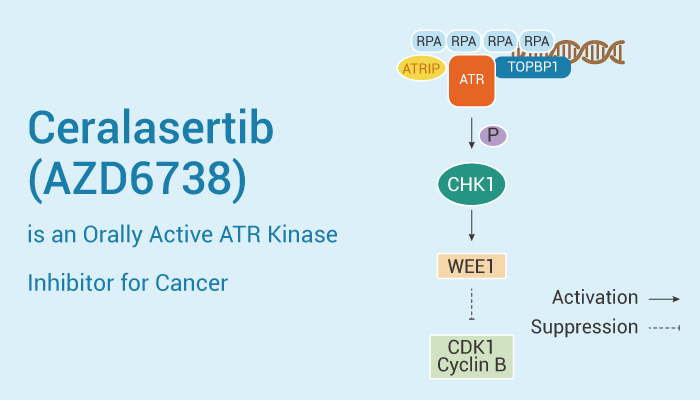ATR kinase is a key component of the DNA damage response pathway. Additionally, it plays a critical role in maintaining genome stability.
Ceralasertib (AZD6738) is a potent inhibitor of ATR kinase activity. Additionally, this compound exhibits an IC50 of 0.001 μM against the isolated enzyme and 0.074 μM against ATR kinase-dependent CHK1 phosphorylation in cells. It has been shown to induce cell death and senescence in non-small cell lung cancer (NSCLC) cell lines. Additionally, it impaired the viability of four Kras mutant cell lines, including H23, H460, A549, and H358. 
The lowest GI50 and greatest maximal inhibition were observed in H460 and H23 cells, at 1.05 μM (88.0%) and 2.38 μM (86.2%), respectively. Moreover, among 13 cell lines including luminal, triple negative, and HER2+ subtype, the IC50 values of nine cell lines were <1 μM.
What’s more, Ceralasertib potentiates the cytotoxicity of CDDP and NSC 613327 in NSCLC cell lines with intact ATM kinase signaling. It potently synergizes with CDDP in ATM-deficient NSCLC cells[1].
Furthermore, Ceralasertib (AZD6738) inhibits human breast cancer cell lines with IC50 values less than 1 μM, as determined by MTT assay. It induces cell cycle arrest and apoptosis, downregulating DNA damage response molecules and cell proliferative signaling molecules[2].
In preclinical studies, daily administration of Ceralasertib (AZD6738) and ATR kinase inhibition for 14 consecutive days exhibited well-tolerance in mice. Additionally, it enhanced the therapeutic efficacy of CDDP in xenograft models. Besides, the combination of CDDP and Ceralasertib (AZD6738) was able to resolve ATM-deficient lung cancer xenografts[1].
In conclusion, AZD6738 is a highly selective, orally active, and potent inhibitor of ATR kinase activity. As a result, it induces ATM kinase-dependent DNA damage signaling and potentiates cell killing.
Reference:
[1]. Vendetti FP, et al. Oncotarget. 2015 Dec 29;6(42):44289-305.
[2]. Kim HJ, et al. Int J Cancer. 2017 Jan 1;140(1):109-119.